Best Bee Plants for Northeast Florida
Dune sunflower (Helianthus debilis)
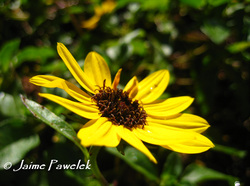
- Asteraceae (Composite Family)
- Low growing annual on coastal dunes
- Blooms most of the summer and fall
- A few plants will spread to cover a large area
- Can get knocked back by freezing temperatures, but will usually reseed the next year
- Good source of nectar and pollen
- Attracts a variety of sweat bees (Agapostemon splendens, Augochlorella aurata, Halictus poeyi) and leaf-cutter bees (Megachile mendica, Megachile pruina, Megachile xylocopoides), just to name a few
- Low growing annual on coastal dunes
- Blooms most of the summer and fall
- A few plants will spread to cover a large area
- Can get knocked back by freezing temperatures, but will usually reseed the next year
- Good source of nectar and pollen
- Attracts a variety of sweat bees (Agapostemon splendens, Augochlorella aurata, Halictus poeyi) and leaf-cutter bees (Megachile mendica, Megachile pruina, Megachile xylocopoides), just to name a few
Blanketflower (Gaillardia pulchella)
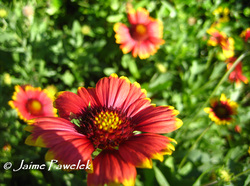
- Asteraceae (Composite Family)
- Short dune annual (~1ft.)
- Blooms almost all year (March-Nov.)
- Easily reseeds itself year after year
- Good source of nectar and pollen
- Attracts sweat bees (Agapostemon splendens, Halictus poeyi), bumble bees (Bombus griseocolis, Bombus impatiens, Bombus pensylvanicus), leaf-cutter bees (Megachile albitarsis, Megachile parallella, Megachile pruina) and a small mining bee (Perdita bequaerti).
- Short dune annual (~1ft.)
- Blooms almost all year (March-Nov.)
- Easily reseeds itself year after year
- Good source of nectar and pollen
- Attracts sweat bees (Agapostemon splendens, Halictus poeyi), bumble bees (Bombus griseocolis, Bombus impatiens, Bombus pensylvanicus), leaf-cutter bees (Megachile albitarsis, Megachile parallella, Megachile pruina) and a small mining bee (Perdita bequaerti).
Turkey tangle fogfruit (Phyla nodiflora)

- Verbenaceae (Verbena Family)
- Low-growing ground cover with small purple/white flowers
- Blooms all summer (May-Oct.)
- Common in disturbed areas and along roads
- Good nectar plant for bees and butterflies
- Attracts a large diversity of bees including sweat bees (Agapostemon splendens, Augochloropsis metallica, Lasioglossum nymphale), and leaf-cutter bees (Megachile albitarsis, Megachile mendica, Megachile texana, Anthidiellum perplexum).
- Low-growing ground cover with small purple/white flowers
- Blooms all summer (May-Oct.)
- Common in disturbed areas and along roads
- Good nectar plant for bees and butterflies
- Attracts a large diversity of bees including sweat bees (Agapostemon splendens, Augochloropsis metallica, Lasioglossum nymphale), and leaf-cutter bees (Megachile albitarsis, Megachile mendica, Megachile texana, Anthidiellum perplexum).
Spanish needles (Bidens alba)
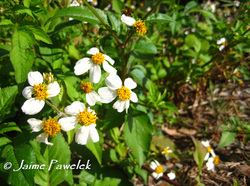
- Asteraceae (Composite Family)
- Medium tall annual (1-3ft.)
- Blooms almost all year (March-Nov.)
- Common in many habitats, especially in urban areas
- Popular source of nectar and pollen, visited by bees and many butterflies
- Attracts many of the common sweat bees (Agapostemon splendens, Augochlorella aurata, Halictus poeyi), leaf-cutter bees (Megachile brevis, Megachile georgica, Megachile texana), as well as bumble bees (Bombus impatiens), cuckoo bees (Coelioxys sayi, Coelioxys slossoni), and carpenter bees (Xylocopa micans).
- Medium tall annual (1-3ft.)
- Blooms almost all year (March-Nov.)
- Common in many habitats, especially in urban areas
- Popular source of nectar and pollen, visited by bees and many butterflies
- Attracts many of the common sweat bees (Agapostemon splendens, Augochlorella aurata, Halictus poeyi), leaf-cutter bees (Megachile brevis, Megachile georgica, Megachile texana), as well as bumble bees (Bombus impatiens), cuckoo bees (Coelioxys sayi, Coelioxys slossoni), and carpenter bees (Xylocopa micans).
Spotted Beebalm (Monarda punctata)
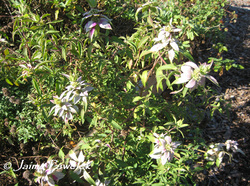
- Lamiaceae (Mint Family)
- Medium tall perennial (2-4ft.)
- Blooms late summer to early fall
- Found near coast on beach/dunes and coastal strand
- Excellent nectar source for bees and many wasps
- Commonly attracts carpenter bees (Xylocopa micans, X. virginica, Ceratina cockerelli), sweat bees (Lasioglossum spp., Halictus spp.), bumble bees (Bombus pensylvanicus), and leaf-cutter bees (Megachile mendica)
- Medium tall perennial (2-4ft.)
- Blooms late summer to early fall
- Found near coast on beach/dunes and coastal strand
- Excellent nectar source for bees and many wasps
- Commonly attracts carpenter bees (Xylocopa micans, X. virginica, Ceratina cockerelli), sweat bees (Lasioglossum spp., Halictus spp.), bumble bees (Bombus pensylvanicus), and leaf-cutter bees (Megachile mendica)
Canadian Germander (Teucrium canadense)
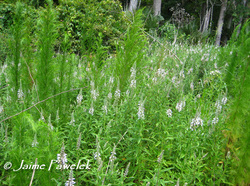
- Lamiaceae (Mint Family)
- 1-3 ft. tall perennial ending in spike of white/lavendar flowers (spreads by underground rhizomes)
- Blooms in mid-summer (June-Aug.)
- Found along wet areas, freshwater marshes, ponds, lakes and prefers moist soils
- Excellent nectar source for bees, butterflies, hummingbirds, and hawk moths
- Commonly attracts several species of leaf-cutter bees (Megachile spp.), carpenter bees (Xylocopa micans and X. virginica), and long-horned bees (Melissodes spp.).
- 1-3 ft. tall perennial ending in spike of white/lavendar flowers (spreads by underground rhizomes)
- Blooms in mid-summer (June-Aug.)
- Found along wet areas, freshwater marshes, ponds, lakes and prefers moist soils
- Excellent nectar source for bees, butterflies, hummingbirds, and hawk moths
- Commonly attracts several species of leaf-cutter bees (Megachile spp.), carpenter bees (Xylocopa micans and X. virginica), and long-horned bees (Melissodes spp.).
